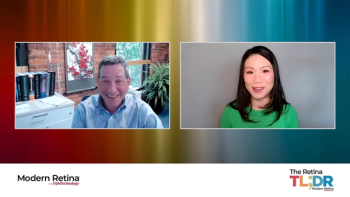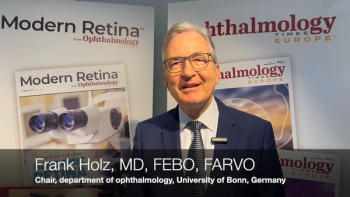
Comparison of brolucizumab and aflibercept for treating DME
A recent study that compared 2 anti-vascular endothelial growth factor drugs for treating diabetic macular edema (DME) found that brolucizumab (Beovu, Novartis) was non-inferior in functional outcomes and superior to aflibercept (Eylea, Regeneron Pharmaceuticals) in anatomic parameters,1 according to first author Leonardo B. Justino from the Division of Medicine, Federal University of Santa Catarina, Florianópolis, SC, Brazil. He was joined in this study by researchers from the Division of Ophthalmology, Governador Celso Ramos Hospital, Florianópolis, SC, Brazil, Tufts Medical Center, New England Eye Center, Boston; and Bascom Palmer Eye Institute, University of Miami, Miami.
The current anti-VEGF treatments for DME are associated with a high treatment burden and poor adherence to the treatment regimen.2 “Besides socioeconomic constraints, which make the ongoing cost and frequency of injections burdensome, patients perceptions of perceived barriers, benefits, and susceptibility play a critical role, as those who underestimate the severity of DME or lack a supportive network are less likely to adhere to treatment regimens,3 the investigators commented.
This result in the need for anti-VEGF therapies that both allow for longer durations between clinical visits and provide good anatomic and functional results.
In light of this, the investigators conducted a meta-analysis of randomized controlled trials to assess efficacy and safety of brolucizumab compared with aflibercept in patients with DME.
Brolucizumab is a single-chain variable fragment with a high binding affinity for VEGF-A isoforms. In addition, its low molecular weight (26 kDa) allows for a molar dosing delivery 11 times higher than aflibercept.4,5
A side effect of concern was intraocular inflammation that developed in patients with neovascular age-related macular degeneration treated with brolucizumab following its approval in 2019.6
The investigators searched Embase, Cochrane Central Register of Controlled Trials, and PubMed databases from inception to February 16, 2024, to identify randomized controlled trials that compared the 2 drugs in patients with DME and reported visual, anatomic, and safety outcomes, they recounted.
Meta-analysis findings
The analysis included data from 1,253 patients (1,253 eyes) from 3 randomized controlled trials. Of these, 57% had been treated with brolucizumab and 43% with aflibercept. The patients had mean follow-up times that ranged from 52 to 100 weeks, the authors reported.
“Brolucizumab was non-inferior to aflibercept when comparing the mean change of best-corrected visual acuity from baseline (least squares mean difference [LSMD] 0.29; 95% confidence interval [CI] − 1.37 to 1.95; p = 0.73). The change in the central subfield thickness was significantly greater in the brolucizumab group compared with aflibercept (LSMD − 24.5 μm; 95% CI − 48.2 to − 0.7 μm; p < 0.05),” they reported.
The 2 drugs did not differ significantly in the incidence rates of adverse events.
The authors concluded, “Our study showed that, despite the noninferiority to aflibercept in functional outcomes, brolucizumab significantly improves anatomic parameters of patients with DME. In contrast to previous studies comparing both anti-VEGF therapies, our meta-analysis did not find statistically significant differences in ocular adverse events between groups (including retinal vasculitis or retinal vascular occlusions). Although having included more participants than previous studies, our findings, supported by trial sequential analysis, underscore the importance of new randomized controlled trials powered to assess safety outcomes in order to suggest brolucizumab as an alternative to the current treatment of DME.”
References
1. Justino LB, Justino GB, Graffunder FP, Binotti WW, Khodor A, Caranfa JT. Brolucizumab versus aflibercept in patients with diabetic macular edema: a meta-analysis of randomized controlled trials. Clin Ophthalmol. 2024;18:3679-3690; https://doi.org/10.2147/OPTH.S487055
2. Long AN, Dagogo-Jack S. Comorbidities of diabetes and hypertension: mechanisms and approach to target organ protection. J Clin Hypertens. 2011;13:244–251; doi:10.1111/j.1751-7176.2011.00434.x
3. Ting Yih Ling J, Mohd Zain A, Naffi AA, Mustapha M, Wan Abdul Halim WH. Determination of factors influencing the health belief model (HBM) and adherence to intravitreal anti-vascular endothelial growth factor (VEGF) among patients with diabetic macular edema (DME). Cureus [Internet]. 2023. [cited October 29, 2024] Available from:https://www.cureus.com/articles/135801-determination-of-factors-influencing-the-health-belief-model-hbm-and-adherence-to-intravitreal-anti-vascular-endothelial-growth-factor-vegf-among-patients-with-diabetic-macular-edema-dme . Accessed November 26, 2024.
4. Sharma A, Kumar N, Kuppermann BD, Bandello F. Brolucizimab—leading an era of structural revolution for long-term VEGF suppression. Eye. 2020;34:611–613; doi:10.1038/s41433-019-0583-z
5. Nguyen QD, Das A, Do DV, et al. Brolucizumab: evolution through preclinical and clinical studies and the implications for the management of neovascular age-related macular degeneration. Ophthalmology. 2020;127:963–976; doi:10.1016/j.ophtha.2019.12.031
6. Khanani A, Brown D, Jaffe G, et al. MERLIN: phase 3a, multicenter, randomized, double-masked trial of brolucizumab in participants with neovascular age-related macular degeneration and persistent retinal fluid. Ophthalmology. 2022;129:974‐985. doi:10.1016/j.ophtha.2022.04.028
Newsletter
Keep your retina practice on the forefront—subscribe for expert analysis and emerging trends in retinal disease management.



















































